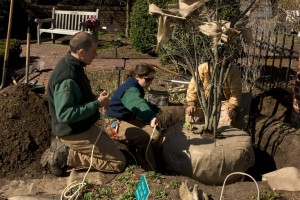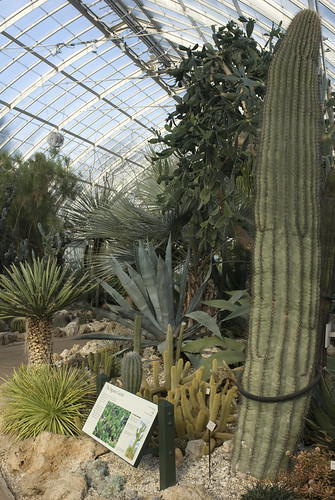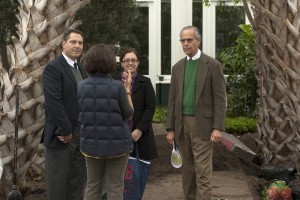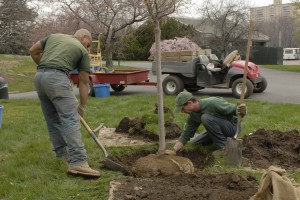Inside The New York Botanical Garden
Archive: February 2010
Posted in Learning Experiences on February 10 2010, by Plant Talk
 Carol Capobianco is Editorial Content Manager at The New York Botanical Garden.
Carol Capobianco is Editorial Content Manager at The New York Botanical Garden.
Liz Costa, Associate Vice President for Corporate and Foundation Relations, and her husband, Rob Yagley, moved in to their own home in September. Their small yard is framed by several trees, which can be challenging to landscape. As their first spring planting season approaches, they decided to seek help from the Botanical Garden’s Continuing Education program.
So both signed up for this Saturday’s Shade Gardening event—a day of classes for gardeners who want to understand the different levels of shade, design shade gardens, choose appropriate plants, and more. Liz and her husband have even split up the chores—she’ll attend three of the six sessions offered and he the other three so that they cover all the topics.
“As apartment dwellers most of our lives, we knew we needed help with our new yard, especially with gardening in the shade,” said Liz. “When we spotted the six different sessions offered on one Saturday, we knew we found the best way to start thinking about our shady spot!”
To find out more about Shade Gardening Saturday or to register, click here and search “shade garden” or call 718.817.8747.
Posted in Learning Experiences on February 9 2010, by Plant Talk
Author of The Garden Primer Encourages Growing Food Year-Round
 |
Barbara Damrosch, author of the recently revised The Garden Primer, writes a weekly column for The Washington Post and has designed display food gardens at Stone Barns Center in Westchester. She will discuss growing food year-round as part of the From the Ground Up Lecture Series on February 18. |
 The anticipation of flavor is the best appetite stimulant, as all kitchen gardeners know. It’s one thing to look forward to a meal, or a favorite dish. But a favorite crop in the ground is even more tantalizing.
The anticipation of flavor is the best appetite stimulant, as all kitchen gardeners know. It’s one thing to look forward to a meal, or a favorite dish. But a favorite crop in the ground is even more tantalizing.
The global supermarket cornucopia dulls the appetite by making every food available. Cooks can make any recipe, at any time, just by tossing ingredients into a cart. As a result, they rarely know seasonal tastes like those of garden peas, sown in early spring and harvested after long anticipation, bursting with sweetness as only fresh-picked peas can. Or the juiciness of the first red, ripe tomato, warm on the vine. Or the first corn, the first melon, the zing of sprightly fall greens such as arugula or mache.
Read More
Posted in Gardening Tips on February 8 2010, by Sonia Uyterhoeven
 |
Sonia Uyterhoeven is Gardener for Public Education. |
 In last week’s blog post, I discussed the virtues and drawbacks of balled and burlapped (B&B), container grown, and bare-root trees. Before I move on to planting particulars, I’d like to first talk about the roots of trees.
In last week’s blog post, I discussed the virtues and drawbacks of balled and burlapped (B&B), container grown, and bare-root trees. Before I move on to planting particulars, I’d like to first talk about the roots of trees.
The average person on the street would probably describe a tree’s root system as made up of large roots that tunnel deep into the ground. The logic is sound—many trees do have deep vertical tap roots that keep them anchored in the ground and stable.
The majority of a tree’s root system, however, spreads horizontally. These roots are just 12 inches deep and stretch and branch over a large surface, producing tiny hair-like roots that absorb water and nutrients. If you’ve ever seen a fallen tree, you’ll note a sizable horizontal slab of soil that had been uprooted with the tree.
Read More
Posted in Wildlife on February 5 2010, by Plant Talk
Owls on Nest Once Again, Waterfowl Add Color to Gray Days
 |
Debbie Becker leads a free bird walk at the Garden every Saturday from 11 a.m. to 12:30 p.m. beginning at the Reflecting Pool in the Leon Levy Visitor Center.
Photos: Debbie Becker
|
 Winter holds its best birding in two areas: owls and ducks. Right now the great horned owls at NYBG are sitting on their nest ready to bring forth a new brood of owlets to delight and amaze us. Anticipated arrival time is the end of February. In the meantime, wander down to the Bronx River and observe the wonderful world of waterfowl on the river. Wood ducks, mallards, one farm duck, and several hooded mergansers have been present on the Bronx River. Ducks are fun to watch, and their brightly-hued feathers add color to gray winter days.
Winter holds its best birding in two areas: owls and ducks. Right now the great horned owls at NYBG are sitting on their nest ready to bring forth a new brood of owlets to delight and amaze us. Anticipated arrival time is the end of February. In the meantime, wander down to the Bronx River and observe the wonderful world of waterfowl on the river. Wood ducks, mallards, one farm duck, and several hooded mergansers have been present on the Bronx River. Ducks are fun to watch, and their brightly-hued feathers add color to gray winter days.
The mergansers can be seen diving under the water searching for small fish and insects. The male’s white crest becomes erect when danger is near or when trying to attract a female during mating season. The females sport a funky spiked hairdo, but their crests are burgundy and subtle. The males often bob their heads in territorial display and are silent most the time.
Read More
Posted in Exhibitions on February 4 2010, by Plant Talk
 |
Laura Collier is Marketing Associate at The New York Botanical Garden |
 Deserts cover about a third of the Earth’s surface but are so extreme that just about 5 percent of the world’s population live there. That doesn’t make them devoid of plant life. Quite to the contrary, thousands of plant species have adapted survival techniques, like sun protection and water storage, to be able to live in the desert climate, and you can see some of these in the Deserts of the World Gallery in A World of Plants in the Enid A. Haupt Conservatory.
Deserts cover about a third of the Earth’s surface but are so extreme that just about 5 percent of the world’s population live there. That doesn’t make them devoid of plant life. Quite to the contrary, thousands of plant species have adapted survival techniques, like sun protection and water storage, to be able to live in the desert climate, and you can see some of these in the Deserts of the World Gallery in A World of Plants in the Enid A. Haupt Conservatory.
Cacti, the plants we typically think of when talking about deserts, come in many shapes and sizes. One of the most famous in the United States is the saguaro of the Sonoran Desert in the southwestern part of the country. Saguaros can grow to 50 feet tall with roots extending 100 feet into the ground, and can live up to 200 years. These giants play an important role in the desert, providing food and shelter for animals, insects, and birds.
Read More
Posted in Exhibitions, The Orchid Show on February 3 2010, by Plant Talk
Designer Visits from Florida to View Progress of Installation
 Jorge Sánchez (right), designer of The Orchid Show: Cuba in Flower, and John C. Lubischer (left), Senior Associate of the Palm Beach-based landscape architectural firm Sánchez & Maddux, visited the Botanical Garden last week to view the progress of the installation, which includes an allée of palm trees, a sugar mill ruin, and other iconic vignettes of Old Havana and the Cuban countryside—amid fabulous orchids. “All the pieces are fitting into place flawlessly—with grace and good humor,” Jorge said. “What a pleasure to be working with such a well-organized group.” Here he talks with Garden staff Francisca Coelho, Senior Curator and Associate Vice President for Glasshouses and Exhibitions (back to camera), and Karen Daubmann, Director of Exhibitions and Seasonal Displays, in the Enid A. Haupt Conservatory, where the exhibition will run from February 27 through April 11.
Jorge Sánchez (right), designer of The Orchid Show: Cuba in Flower, and John C. Lubischer (left), Senior Associate of the Palm Beach-based landscape architectural firm Sánchez & Maddux, visited the Botanical Garden last week to view the progress of the installation, which includes an allée of palm trees, a sugar mill ruin, and other iconic vignettes of Old Havana and the Cuban countryside—amid fabulous orchids. “All the pieces are fitting into place flawlessly—with grace and good humor,” Jorge said. “What a pleasure to be working with such a well-organized group.” Here he talks with Garden staff Francisca Coelho, Senior Curator and Associate Vice President for Glasshouses and Exhibitions (back to camera), and Karen Daubmann, Director of Exhibitions and Seasonal Displays, in the Enid A. Haupt Conservatory, where the exhibition will run from February 27 through April 11.
Get Your Tickets
Posted in Learning Experiences on February 2 2010, by Plant Talk
GEAR UP Introduces Students to Careers in Plant Sciences
 |
Yadana Desmond is Program Coordinator and Instructor for the GEAR UP program at the Botanical Garden. |
It was a cold Saturday morning in January, a day off for most students, but 27 ninth graders from area high schools were intently studying the artwork in the gallery exhibition of the LuEsther T. Mertz Library and the plants in the Garden’s Enid A. Haupt Conservatory, absorbing every detail to later create their own ink and watercolor illustrations. In the afternoon they would go on to make cell and anatomical observations of plant slides under the microscope. And this was just Day 1 of the 9-session course.
It was all part of GEAR UP, a federal initiative administered locally by the Bronx Institute at Lehman College that partners with community institutions such as the Botanical Garden to prepare middle and high school students for college and careers.
Read More
Posted in Gardening Tips on February 1 2010, by Sonia Uyterhoeven
 |
Sonia Uyterhoeven is Gardener for Public Education. |
 One of the highest arts or noblest feats in life is to put new and ambitious ideas into practice. New Yorkers were promised “a million trees” to green the city, combat greenhouse gases, and improve the quality of life. Can it be done? Thanks to some phenomenal research by the Urban Horticulture Institute at Cornell University that makes planting street trees easier, the answer from the horticultural side of the equation is “yes.”
One of the highest arts or noblest feats in life is to put new and ambitious ideas into practice. New Yorkers were promised “a million trees” to green the city, combat greenhouse gases, and improve the quality of life. Can it be done? Thanks to some phenomenal research by the Urban Horticulture Institute at Cornell University that makes planting street trees easier, the answer from the horticultural side of the equation is “yes.”
Trees are sold three ways—balled and burlapped (B&B, see photo), container grown, or bare root. They all have their advantages and disadvantages when it comes time to plant.
Read More
 Carol Capobianco is Editorial Content Manager at The New York Botanical Garden.
Carol Capobianco is Editorial Content Manager at The New York Botanical Garden.










